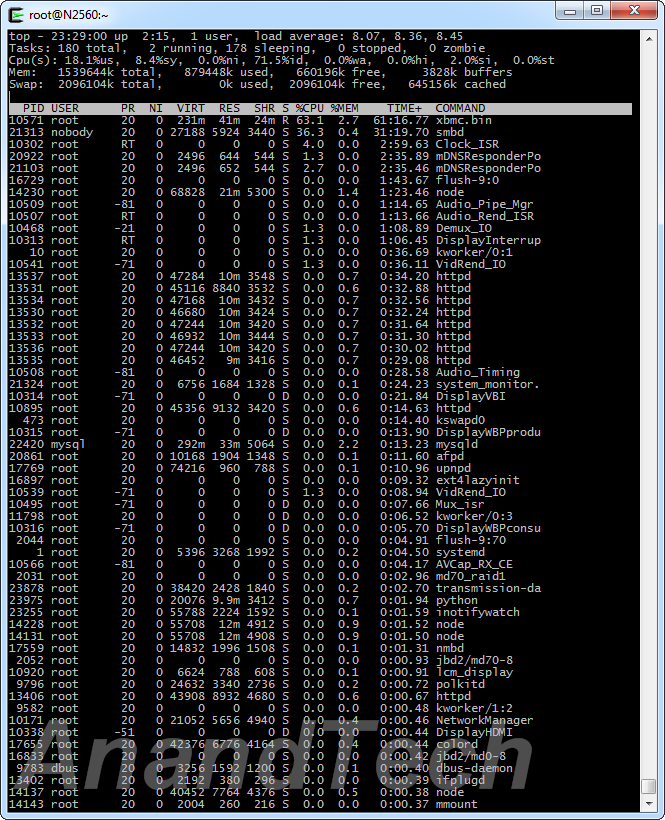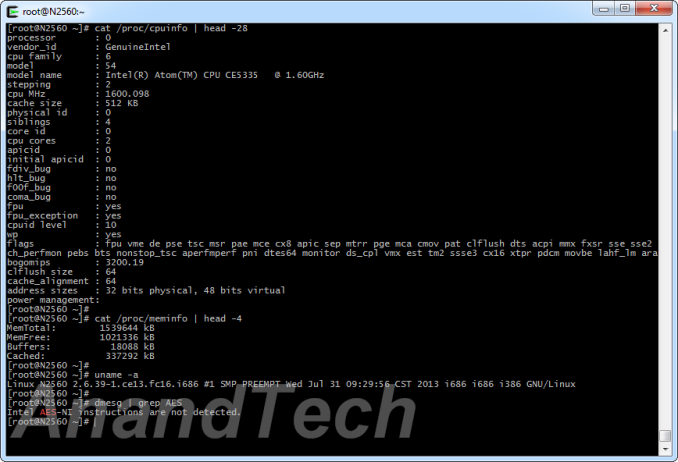Thecus N2560: Intel's EvanSport NAS Platform Review
by Ganesh T S on November 25, 2013 3:30 PM ESTSetup and Usage Impressions
Thecus makes it pretty clear on the package that the N2560 is meant for the average home consumer. There are claims of getting a complete installation up and running in 5 minutes and automatic RAID creation. Quietness and energy efficiency are also touted. The unit comes with a 40W DC adapter (12V @ 3.33A), a 3ft Cat 5 Ethernet cable, CD with firmware and allied software utilities, a warranty card and a quick start guide. The unit has a very plastic feel to it and doesn't look very well built (which is probably OK for a budget NAS).
The more obvious issue is the drive insertion mechanism. Instead of the standard drive bays which involves screwing in the drives, Thecus opts to make things easier for the users by doing away with separate drive holders. Four plastic strips are provided to place on either side of a 3.5" drive and these help in stabilizing them when being inserted into the drive slots. However, the mechanism didn't leave me with a positive impression. On the I/O side, we have both HDMI and SPDIF. These point to the multimedia focus of the N2560.
Internally, the Thecus N2560 uses the Intel CE5335 SoC with the Atom cores running at 1.6 GHz. These are the pervious generation Atom cores, which means no AES-NI support. The unit has 2 GB of RAM, but almost a fourth of it is reserved for the GPU. The OS itself is based on Linux kernel version 2.6.39.
Thecus expects users to use the Intelligent NAS utility (based on Adobe Air) to configure the NAS. While I found it passable to get the unit up and running, I felt more at ease with the browser interface. The Intelligent NAS utility provides information on the various file types stored currently in the NAS, configuration of copy tasks, a provision for firmware update and setup of cloud access with dynamic DNS. All in all, things that the average consumer should be quite happy with when taking advantage of the NAS.
Unfortunately, Thecus hasn't paid that much attention to the browser UI functions, which meant some of the options didn't work as intended. The most obvious issue was the fact that RAID rebuild failed when I tried to test that feature out. Interestingly, this was one of the issues I had reported to Thecus when evaluating the N4800 unit. Thecus units have consistently failed this test and despite the fact that I got the rebuild to work after a couple of attempts, I would have been certainly spooked if I had valuable data on the NAS.
Contributing to the multimedia focus is the presence of XBMC as an installable package. When I tested it out, the interface was restricted to 720p60. There was no HD audio passthrough, and multiple media files from our media streamer test suite just refused to play. I also found that XBMC loaded up more than 50% of the CPU even with the HDMI port disconnected. If one is not using that feature, it is advisable to terminate the process so that the CPU power is available for other NAS functions.

I wouldn't consider XBMC as a killer feature for the N2560. Currently, it is pretty half-baked. We have to wait and watch if Thecus is able to make any progress on this feature which currently seems like a novelty. Thecus claims on their product page that they are working with Intel to get the XBMC app out of the beta phase.
One of the apps available on the N2560 is the Plex Media Server. While trying to play back media on a mobile device with transcoding, we found that Plex doesn't take advantage of the transcoder built into the CE5335. With a single stream, CPU usage went up as high as 90%. Without taking advantage of the hardware transcoder, it is not going to be possible to stream multiple videos to multiple mobile devices.
In terms of miscellaneous features, we find that the N2560 doesn't support iSCSI or NFS. While the former can be excused in a NAS targeting home users, I find the absence of NFS very puzzling. Many media streamers work well with NFS shares. The N2560 doesn't support encrypted volumes or folders, though that can be excused in this market segment. However, Thecus does claim AES 256-bit encryption support for volumes on its product page. It is supposed to make an appearance in one of the upcoming firmware releases.





























73 Comments
View All Comments
chizow - Monday, November 25, 2013 - link
It's not just the extra "physical" bays, it's the extra support for the extra features as well as the additional CPU grunt and RAM you generally get with these upgraded units. These add up to additional premium that you undoubtedly see in review results whne jumping up from entry level 2-bay to 4-6-8 bay SOHO NAS units.otherwise - Tuesday, November 26, 2013 - link
For the two NAS' ace240; the software; CPU; and Memory is the same.Gigaplex - Monday, November 25, 2013 - link
What they charge and how much it costs them to make are separate things.Solandri - Wednesday, November 27, 2013 - link
But addressing the GP's original question, the cost to make these things does not matter. People keep buying the 2-bay NASes because the manufacturers keep pricing them 4-bay NASes substantially higher.The price premium was big enough for me to build my own 4-drive homebrew NAS. For non-techy people (e.g. my parents) I just get them a 2-bay off-the-shelf NAS.
Hrel - Tuesday, November 26, 2013 - link
I'm sure you're right on actual cost. But the 4 bay ones start $200 higher than the 2 bay NAS's. So it makes a lot more sense to buy a 2 bay NAS in RAID 0 and if you want your data backed up beyond that to just use the cloud or external hdd's.easp - Tuesday, November 26, 2013 - link
Why do people continue to think that products are or should be priced on marginal cost? The up-front engineering and product development costs are often a significant consideration.These engineering efforts are generally focused on an entire product family, and the overall economics of the product family are often predicated on the fact that some of the members of the product line will have larger margins, and others will have smaller margins. Moreover, it is the lower-end items that tend to have the smallest margins, so taking the low-end products as the baseline further distorts the conclusions.
brucek2 - Wednesday, November 27, 2013 - link
This website caters to many hardware enthusiasts who frequently build their own systems, including servers and/or storage systems. If a manufacturer is going to arbitrarily add phantom costs to build(s) with certain configurations, it means that enthusiasts who want those configurations will be more likely to build vs buy in those cases (or switch to the more cost effective configurations.)I have no problem with manufacturers recovering their R&D and making profits. It just sounds in this case like both the hardware BOM and the R&D are very similar for the two models, leading to what I feel is a legitimate question why one would be priced at double the cost of the other.
easp - Thursday, December 5, 2013 - link
Enthusiasts often make the mistake of thinking that they are the target market for every product they see. They aren't, particularly when they don't value their time very highly. I'm guilty of the latter (I buy cheap Xyzel NASs when they are on sale for the purpose of running debian), but I try hard to avoid the former.As to your sense that both hardware BOM and R&D are very similar for the two models, my original point is that reaching that conclusion suggests deeply flawed assumptions. R&D (and marketing costs) costs aren't distributed equally across all members of product families. Some models will have lower prices, lower cost of goods sold and lower margins, while others have higher cost of goods, and disproportionately higher margins and final selling price.
If it helps, look at it this way, if every tier in a product family bore an equal share of R&D and marketing costs, with consistent margins, then the higher-tier models would be somewhat cheaper, but the lower-tier models would be more expensive.
ShieTar - Wednesday, November 27, 2013 - link
Difficult to say. With four drives instead of two, you get more heat, more vibrations, more mass. You might hit some design threshold, where all of a sudden you need to have a wider base, use different screws for fixation or add another cooling component.I also think that there are actually plenty of customers who are happy with even a single drive in one of those. Just something to put movies and music on for all family members, and if the drive fails, so what. Its not like anybody made backups of his videotapes in the last century. So for the mass market, it probably makes sense to have a inexpensive 2-Bay unit, plenty of people will check for the cheapest unit which supports what they plan to do.
puremind - Saturday, November 30, 2013 - link
Why would you want an extra Bay if you are not prepared to purchase extra drives anyways?